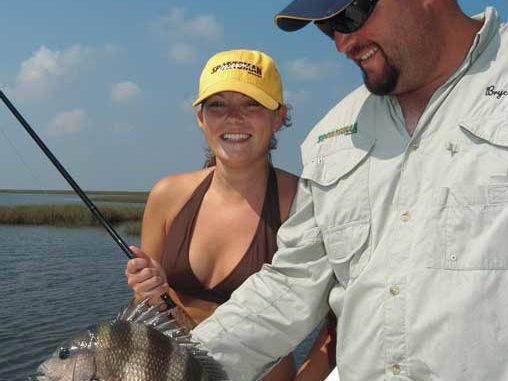
Here’s a look at some more trophies that were dropped during the 2007-08 season.
Some fish just don’t get any respect. The sheepshead is one of those. It is attractively colored, grows to a decent size, is a dogged fighter and may be the best, or at least second best, tablefish in the marsh. But few anglers head out on a trip with sheepshead as their main target. Maybe it’s the name; it is so off-putting that the U.S. Food & Drug Administration in 2004 approved a name change for commercially sold sheepshead in Louisiana to “rondeau seabream.”
More than likely, it’s because sheepshead are way too smart to mistake a chunk of plastic and metal as something good to eat. One of the requirements to be defined as a game fish is a willingness to try to eat fake food.
The current world record sheepshead, 21 pounds, 4 ounces, was caught in 1982 in Louisiana by Wayne Deselle, so we know that Louisiana has big sheepshead. And we have a lot of them, spread all over our vast brackish and salt marshes.
Yet, in a survey of recreational fishermen published in 1990, only 4 percent of the catch by saltwater sports fishermen was sheepshead, and they kept only 60 percent of the ones they caught.
And the fish hasn’t gotten any more popular since then.
The sheepshead is a very common member of the Sparidae family, also known as porgies. Most porgies are offshore fish, and most are found near or on reefs and other hard structure.
Other members of the family found in Louisiana’s offshore waters are the jolthead porgy, the knobbed porgy and the red porgy. Some of these are referred to by fishermen as “white snappers.” They are not, of course, snappers, but like snappers, they all have a delicious white flesh.
Commercial fishermen, on the other hand, have no qualms about targeting them. And Louisiana’s finest restaurants list them on their menus.
Commercial landings remained modest until 1983, when they began to grow. In 1987, the year that redfish, were declared game fish, sheepshead landings made a big jump. Landings peaked at over 3.7 million pounds in 1993, then slowed somewhat, although never dropping below 1.5 million pounds until Hurricanes Katrina and Rita decimated both the Louisiana economy and many of its fishing communities. Most of the current catch is produced from trawls.
Department of Wildlife and Fisheries stock assessments regularly estimate the spawning potential ratio (SPR) for sheepshead to be well above the 30-percent conservation standard. SPR is the yardstick by which the health of a fish population is often measured. It is simply the ratio of the egg-producing ability of all the mature fish in a fished stock as compared to the egg-producing ability that would exist if the stock was unfished.
Sheepspead spawn in Louisiana between February and May. This occurs at about the time that they group into schools in waters outside the beaches. They spawn at about 2 years old, weighing ½ to 1¾ pounds. The young hatchlings make their way into marshland estuaries after hatching, and seem to prefer hard bottoms like oyster reefs.
While sheepshead are in their spawning schools, they become easy targets, tending to gravitate toward man-made structures, such as oil and gas wellheads, both in major bays and nearshore waters outside the beachline. At this time, big catches can quickly be made with equipment no more complicated than a shrimp-baited line on a cane pole.
Sheepshead have been recorded as old as 20 years. Females grow more rapidly than males. At 20 years old, males average a little over 4 pounds and females are about 5½ pounds. Growth is rapid until 6 to 8 years of age, after which it slows dramatically, especially for males.
The most interesting thing about sheepshead biology is their food habits. In a nutshell, they eat everything. A study in Texas showed them eating mostly plants and algae and a few crabs. In the Florida Everglades, fish over 3 inches long ate mostly mollusks (mussels, clams, etc) and barnacles. In Mississippi, researchers found that fish 6 to 14 inches long ate mollusks and plants. Larger sheepshead ate mollusks, crustaceans (crabs, etc), bottom worms and quite a bit of fish, mostly anchovies. They did note that when sea grasses or algae were plentiful that sheepshead will occasionally feed heavily on them.
A Lake Ponchartrain study showed that by volume, 54 percent of their diet was plants, 19 percent mussels, 10 percent sponges, 8 percent clams, 3 percent croakers and other fish and almost 2 percent mud crabs. Barnacles and blue crabs made up less than 1 percent each of their diet.
Jerald Horst is an author of the Angler’s Guide to Fishes of the Gulf of Mexico, a 444-page, color-illustrated book on fishes written for saltwater fishermen. The book is available in better bookstores, or can be ordered by calling 800-843-1724.


